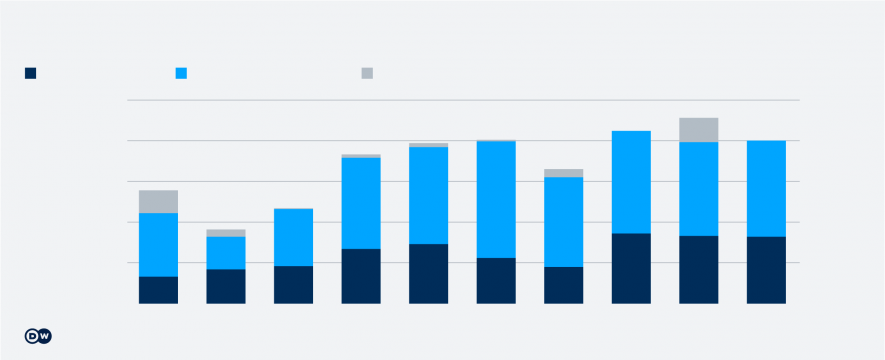Indigenous Peoples and Their Fight For Conservation
An Indigenous man pictured during a protest against the disappearance of Indigenous expert Bruno Pereira
Indigenous peoples around the world are defending their human rights and culture as well as nature and their homeland. Time and again, they are faced with massive repression, discrimination and racism. There are approximately half a billion Indigenous people worldwide.
Defending their rights often goes hand in hand with a call for betterenvironmental and climate protection. They frequently pay for it with their lives.
Between 2012 and 2021, human rights groups and organizations documented the deaths of more than 1,700 environmental and homeland defenders in some 60 countries. More than 35% of those killed were identified as Indigenous people, according to data published by environmental and human rights organization Global Witness.

At the heart of the conflict are often major mining industry projects, wood clearing for the purpose of farming, reservoir dams, and extraction of oil, gas and coal.
Australia's First Nation People: 'We're seen as petitioners'
"Our people lived on this continent for over 60,000 years," Adrian Burragubba, the leading cultural custodian of the Jagalingou people, told DW.
The Jagalingou, an Aboriginal tribe in Australia, fought against the construction of the Carmichael coal mine instigated by India's Adani corporation in the Australian state of Queensland. Ultimately, they lost: the coal mine, which became a political issue in Australia, started production in 2021 following vehement protests.

Tribal leader Adrian Burragubba speaks during a rally at Queensland Parliament in Brisbane
According to media reports, mining could cause water levels of underground springs to drop. For the Indigenous people, the springs are sacred and are essential for the survival of the local environment. Other issues included air, noise and light pollution around the clock, Barragubba said. Mining also had an impact on insect populations, with ramifications for the whole ecosystem, he added.
Prior to the construction, activists already warned of consequences for the local environment and even for the famous Great Barrier Reef located off the Australian coast. It was feared that additional maritime traffic close to the Reef could inflict further damage to the sensitive ecosystem. In addition, there were effects on the climate. Large parts of the Reef have already been destroyed, partially because of global warming.
During its projected 60-year lifetime, the mine could emit nearly 2% of the total amount of carbon dioxide still available to humans in order to limit global warming to 1.5 degrees.

An Aboriginal Australian performs a traditional dance during Invasion Day protest at Belmore Park on January 26, 2023 in Sydney
Since the era of colonization, Australia's Indigenous people have been exposed to racism and discrimination. Barragubba said that if their native land is not handed over to them, the Jagalingou can at least try and beat the government at its own game, namely through exercising human rights. They continue to visit their holy sites near the mining area and celebrate their ceremonies.
"We have taken up occupation," said Barragubba, adding that free practice of religion was a fundamental human right: nobody could stop them from doing it.
The price for Philippine gold could be paid by millions
Another hotspot is located in the northeast of the Philippines, where the Australian mining company OceanaGold owns a gold and copper mine. During the first half of 2023, the Didipio mine produced 65,241 ounces of gold and 6,911 tons of copper. Often, toxic chemicals like arsenic and mercury are used in the course of the mining process. A United Nations report from 2019 establishes a correlation between dying trees in the vicinity of the mine and allegedly contaminated water with the mining activity.
For years, the Indigenous communities at the Didipio river have been fighting for the right to live on their homeland, said Pedro Arrojo-Agudo, UN special rapporteur on the human rights to safe drinking water and sanitation. Protecting the land, the forest, the river and, eventually, drinking water was of general interest to the populations, he told DW.
"The problem with heavy metals is when you drink water contaminated with heavy metals, you don't realize that it is dangerous. So you have an accumulative process of poisoning people for decades."

The mining of precious metals has a price for humans and for the environment. This picture shows a mine in Sudan
During the last couple of years, there were repeated protests by local Indigenous groups. Some of them were brutally crushed by the police and the army. There were arrests and forced evictions, according to Arrojo-Agudo, who continues to observe the situation.
In the long run, contamination of the water would not only have "large and very grave health impacts" in upstream areas, but also for millions of people living further down, within the entire river basin. Various UN experts called on the Philippine government not to discriminate Indigenous communities in favor of economic interests.
OceanaGold's mining license expired in 2019 but was renewed in 2021 for another 25 years.

Forest fires, illegal deforestation, farming and infrastructure projects: The Amazon jungle continues to shrink
Amazon: Custodians of the forest under threat
The Amazon, the "green lung of the planet," spreads out over nine countries. The gigantic jungle is one of the most biodiverse regions of the world. It is also the home of overall 1.5 million Indigenous people, comprising more than 380 ethnic groups. They are regarded as custodians of the forest, which has dwindled dramatically in recent decades as a result of legal and illegal deforestation, drug trafficking, infrastructure projects, farming and corruption.

Amazon tribal leader and climate activist Kreta Kaingang speaks during a demonstration at the UN climate conference in Glasgow, Scotland
Be it illegal displacement or inability of authorities to enforce existing laws, time and again Indigenous people get caught in the crossfire of drug cartels, the military, security personnel of private companies, militias and guerillas.
Colombia and Brazil, two countries from the region, rank at the top of the list of murders of (Indigenous) conservationists committed worldwide. Dark figures of killings around the globe continue to remain high; the higher number of killings recorded in those two countries is also a result of improved documentation.

The destruction of the Amazon forces Indigenous people to resettle and to discard their traditional lifestyle, which has a negative effect on the climate as well. "They play a critical role in the conservation of the forest, and also in the restoration of the forest," said biologist Mercedes Bustamante, a member of the Brazilian Academy of Sciences.
"The deforestation rates in Indigenous lands are the lowest in Brazil and other parts of South America as well. And they also have the knowledge, the traditional knowledge, on how to manage the forests (while) still preserving the forest."
This is primarily a result of their world view. Indigenous peoples defined the relationship between humans and nature in a different way, Dario Mejia Montalvo, a member of the Indigenous Zenu community in Colombia and chair of the UN Permanent Forum on Indigenous Issues, told DW: There was a different value system, a different view of the world, which included all living creatures as well as rivers and mountains. Therefore, a bond and coexistence between humans and nature was achievable in their territories.
This article was translated from German.
Get the latest reports & analysis with people's perspective on Protests, movements & deep analytical videos, discussions of the current affairs in your Telegram app. Subscribe to NewsClick's Telegram channel & get Real-Time updates on stories, as they get published on our website.
























